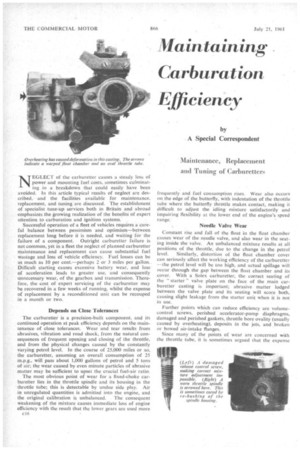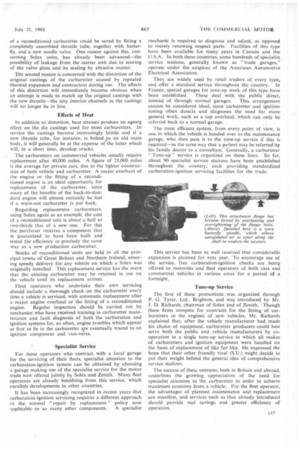.iia in ta in big
Page 52

Page 53

If you've noticed an error in this article please click here to report it so we can fix it.
Carburation Efficiency
by A Special Correspondent Maintenance, Replacement and Tuning of Carburetter
NEGLECT of the carburetter causes a steady loss of power and mounting fuel costs, sometimes culminating in a breakdown that could easily have been avoided. In this article typical results of neglect are described, and the facilities available for maintenance, replacement, and tuning are discussed. The establishment of specialist tune-up services both in Britain and abroad emphasizes the growing realization of the benefits of expert attention to carburation and ignition systems.
Successful operation of a fleet of vehicles requires a careful balance between pessimism and optimism—between replacement long before it is needed. and waiting for the failure of a component. Outright carburetter failure is not common, yet in a fleet the neglect of planned carburetter maintenance and replacement can cause substantial fuel wastage and loss of vehicle efficiency. Fuel losses can be as much as 10 per cent.—perhaps 2 or 3 miles per gallon. Difficult starting causes excessive battery wear, and loss of acceleration leads to greater use, and consequently unnecessary wear, of the gearbox and transmission. Therefore, the cost of expert servicing of the carburetter may be recovered in a few weeks of running, whilst the expense of replacement by a reconditioned unit can be recouped in a month or two.
Depends on Close Tolerances The carburetter is a precision-built component, and its continued operation at peak efficiency depends on the maintenance of close tolerances. Wear and tear results from abrasives, vibration and road shock, from the natural consequences of frequent opening and closing of the throttle. and from the physical changes caused by the constantly varying petrol level. In the course of 25,000 miles or so, the carburetter, assuming an overall consumption of 25 m.p.g., will pass about 1,000 gallons of petrol and 5 tons of air; the wear caused by even minute particles of abrasive matter may be sufficient to upset the crucial fuel-air ratio.
The most obvious point of wear for a fixed-choke carburetter lies in the throttle spindle and its housing in the throttle tube; this is detectable by undue side play. Air in unregulated quantities is admitted into the engine, and the original calibration is unbalanced. The consequent weakening of the mixture causes immediate loss of engine efficiency with the result that the lower gears are used more c16 frequently and fuel consumption rises. Wear also occurs on the edge of the butterfly, with indentation of the throttle tube where the butterfly throttle makes contact, making it difficult to adjust the idling mixture satisfactorily and impairing flexibility at the lower end of the engine's speed range.
Needle Valve Wear
Constant rise and fall of the float in the float chamber causes wear of the needle valve, and also wear in the seating inside the valve. An unbalanced mixture results at all positions of the throttle, due to the change in the petrol level. Similarly, distortion of the float chamber cover can seriously affect the working efficiency of the carburetter —the petrol level will be too high, and actual spillage will occur through the gap between the float chamber and its cover. With a Solex carburetter, the correct seating of the "starter" valve plate on the face of the main carburetter casting is important; abrasive matter lodged between the valve plate and its seating will score both. causing slight leakage from the starter unit when it is not in use.
Further points which can reduce efficiency are volumecontrol screws, perished accelerator-pump diaphragms, damaged and perished gaskets, throttle bore ovality (usually caused by overheating), deposits in the jets, and broken or bowed air-intake flanges.
Since many of the points of wear are concerned with the throttle tube, it is sometimes argued that the expense of a reconditioned carburetter could be saved by fitting a completely assembled throttle tube, together with butterfly, and a new needle valve. One reason against this, concerning Solex units, has already been advanced—the possibility of leakage from the starter unit due to scoring of the valve plate and its seating by abrasive matter.
The second reason is concerned with the distortion of the original castings of the carburetter caused by repeated thermal expansion and contraction during use. The effects of this distortion will immediately become obvious when an attempt is made to match up the original castings with the new throttle—the tiny interior channels in the castings will no longer be in line.
Effects of Heat
In addition to distortion, heat stresses produce an ageing effect on the die castings used for most carburetters. In service the castings become increasingly brittle and if a new throttle tube, for instance, is bolted to an old main body, it will generally be at the expense of the latter which will, in a short time, develop cracks.
The carburetters on commercial vehicles usually require replacement after 40,000 miles. A figure of 25,000 miles is the average for private cars, due to the lighter construction of both vehicle and carburetter. A major overhaul of the engine or the fitting of a reconditioned engine is an ideal opportunity for replacement of the carburetter, since many of the benefits of the back-to-standard engine will almost certainly be lost if a worn-out carburetter is put back.
Regarding replacement carburetters, using Soles again as an example, the cost of a reconditioned unit is about a half to two-thirds that of a new one. For this the purchaser receives a component that is guaranteed to have been built and tested for efficiency in precisely the same way as a new production carburetter.
Stocks of reconditioned units are held in all the principal towns of Great Britain and Northern Ireland, ensuring speedy delivery for any vehicle on which a Solex was originally installed. This replacement service has the merit that the existing carburetter may be retained in use on the vehicle until its replacement arrives.
Fleet operators who undertake their own servicing should include a thorough check on the carburetter every time a vehicle is serviced, with automatic replacement after a major engine overhaul or the fitting of a reconditioned engine. Regular inspection should be carried out by mechanics who have received training in carburetter maintenance and fault diagnosis of both the carburation and ignition systems for, so often, engine troubles which appear at first to lie in the carburetter %re eventually traced to an ignition component and vice-versa.
Specialist Service
For those operators who contract with a local garage for the servicing of their fleets, specialist attention to the carburation-ignition system can be obtained by choosing a garage making use of the specialist service for the motor trade now offered jointly by Solex and Zenith. Many fleet operators are already benefiting from this service, which parallels developments in other countries.
It has been increasingly recognized in recent years that carburation-ignition servicing requires a different approach to the normal "repair by replacement" policy now applicable to so many other components. A specialist
mechanic is required to diagnose and adjust, as opposed to merely renewing suspect parts. Facilities of this type have been available for many years in Canada and the U.S.A. 1n both these countries, some hundreds of specialist. service stations, generally known as "trade garages," operate under the auspices of the American Automotive Electrical Association.
They are widely used by retail traders of every type, and offer a standard service throughout the country_ in France, special garages for tune-up work of this type have been established. These deal with the public direct, instead of through normal garages. This arrangement cannot be considered ideal, since carburetter and ignition tuning often detects and diagnoses the need for more general work, such as a top overhaul, which can only be referred back to a normal garage.
The most efficient system, from every point of view, is one in which the vehicle is handed over to the maintenance garage, who then pass it to the tune-up service if this is required—in the same way that a patient may be referred by his family doctor to a consultant. Generally, a carburetter "Tune-up" service is organized on these lines. So far, about 90 specialist service stations have been established throughout the country, each providing standardized carburation-ignition servicing facilities for the trade.
This service has been so well received that considerable expansion is planned for next year. To encourage use of the service, free carburation-ignition checks are being offered to motorists and fleet operators of both cars and commercial vehicles in various areas for a period of a fortnight.
Tune-up Service The first of these promotions was organized through P. G. Tyrer, Ltd., Brighton, and was introduced by Mr. J. D. Richards, chairman of Solex and of Zenith. Though these firms compete for contracts for the fitting of carburetters to the engines of new vehicles, Mr. Richards explained that, after the vehicle manufacturer had made his choice of equipment, carburetter producers could best serve both the public and vehicle manufacturers by cooperation in a single tune-up service in which all makes of carburetters and ignition equipment were handled on the basis of replacement of like for like_ He expressed the hope that their other friendly rival (S.U.) might decide to put their weight behind the general idea of comprehensive service stations.
The success of these ventures, both in Britain and abroad, underlines the growing appreciation of the need for specialist attention to the carburetter in order to achieve maximum economy from a vehicle. For the fleet operator, the advantages of planned maintenance and replacement are manifest, and services such as that already introduced should provide real savings and greater efficiency of operation.
























































































































